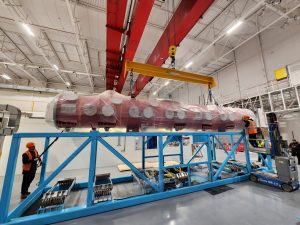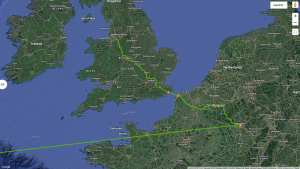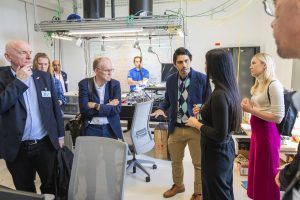A highly technical and delicate piece of equipment weighing 27,500 pounds, or 12,500 kilograms, just made a whirlwind transatlantic trip in its custom transportation frame.
The fully equipped prototype of a cryomodule is one of the many components that will be part of the new linear particle accelerator at the U.S. Department of Energy’s Fermi National Accelerator Laboratory. The successful shipment was an important transportation test and part of Fermilab’s Proton Improvement Plan II project, PIP-II, which receives contributions from several international partners, including the United Kingdom.
The PIP-II project team is constructing a 215-meter-long, state-of-the-art superconducting particle accelerator to upgrade Fermilab’s accelerator complex. At 10 meters long, the HB650 is the largest cryomodule needed for the new accelerator. Four modules will make up the last section of the new machine. When complete, the PIP-II accelerator will produce the world’s most powerful neutrino beam for the international Deep Underground Neutrino Experiment, hosted by Fermilab.

Members of the PIP-II team from Fermilab and STFC UKRI stand in front of the prototype HB650 cryomodule at Daresbury Laboratory. Credit: STFC
Neutrinos are the most abundant matter particles in the universe. By sending neutrinos from Fermilab, close to Chicago, to the huge detectors of DUNE in Lead, South Dakota, physicists can study the particles’ mysterious behavior and search for answers to the universe’s biggest questions.
PIP-II will receive components from partner institutions in France, India, Italy, Poland and the United Kingdom. Fermilab will receive three assembled cryomodules — known as HB650 for the radio frequency they use to operate — from their partners at the Science and Technology Facilities Council in the U.K. and ten similar ones from partners at Commissariat à l’Énergie Atomique et aux Énergies Alternatives, or CEA, in France.
To ensure that all three cryomodules make it safely from STFC’s Daresbury Laboratory near Liverpool to Fermilab, the PIP-II team is conducting extensive tests of the transportation system. Shipping the prototype cryomodule from Fermilab to the U.K. and back was the final test before shipping the first actual cryomodule built in the U.K. to the United States.
In 2022, the collaboration assembled a special transportation frame, designed to fit the HB650 cryomodule, at Fermilab. STFC led the frame’s development with assistance from PIP-II collaborators at Fermilab and CEA in France.

The prototype HB650 cryomodule, wrapped in plastic, is lowered into its custom transport frame after being inspected at Daresbury Laboratory. Credit: Jeremiah Holzbauer, Fermilab
The PIP-II team then performed a successful transportation test with the frame and concrete blocks with the dimensions, weight and mounting points of the actual cryomodule.
PIP-II staff completed the prototype HB650 cryomodule at Fermilab in early 2023. It includes three superconducting radio-frequency cavities for particle acceleration made by partners at the Raja Ramanna Centre for Advanced Technology, provided as in-kind contributions from India.
The first of its kind in the world, the cryomodule underwent months of testing before the PIP-II team loaded it into the transportation frame for its trip to the U.K. and back. It departed Fermilab on Nov. 27. The cryomodule flew on a cargo plane to Luxembourg and then rode on a truck to Daresbury Laboratory, where it was tested. It returned to Fermilab along the same route and arrived on Dec. 14.

The PIP-II team tracked the prototype cryomodule with a GPS device as it traveled from Fermilab to Daresbury Laboratory in the United Kingdom. This map shows the European leg of its journey. Credit: Adam Wixson, Fermilab
The successful completion of this test is the final demonstration that the many challenging aspects of transporting cryomodules are well understood. This includes logistics, customs, handling, instrumentation and, especially, the detailed design of the many delicate components in the cryomodule.
“Our partners require that we manage the risks of this equipment transportation,” said Jeremiah Holzbauer, PIP-II scientist and former transportation manager. “This successful transport of a real cryomodule to and from a partner institution is the proof that we can execute what the project needs. We encountered and overcame many challenges during our tests. In the end, the prototype cryomodule shipment went basically flawlessly — and that’s because we were well prepared.”
Fermi National Accelerator Laboratory is supported by the Office of Science of the U.S. Department of Energy. The Office of Science is the single largest supporter of basic research in the physical sciences in the United States and is working to address some of the most pressing challenges of our time. For more information, please visit science.energy.gov.
Researchers are collaborating across the world to encode information using quantum science to perform powerful calculations and distribute information across networks.
On Nov. 15, a delegation of researchers from the United Kingdom visited the U.S. Department of Energy’s Fermi National Accelerator Laboratory to see firsthand the lab’s efforts to advance quantum information science.
The U.K. and the U.S. are no strangers when it comes to collaborating on quantum research. In 2021, a joint statement between the U.S. and U.K. set the stage for the two countries to team up to tackle some of the biggest challenges in quantum information science.
The delegation represented researchers from across the British government, industry and academia who conduct research in quantum science and technology. They met with Fermilab’s leadership team and discussed opportunities to collaborate on quantum networks.

A delegation of researchers from the U.K visited Fermilab in November. At the Quantum Network Lab, they learned how Fermilab can send entangled quantum information to partner labs across Illinois. From left: Gerald Buller, Heriot Watt University; Richard Penty, University of Cambridge; Cristian Peña, Fermilab; Carmen Palacios-Berraquero, NuQuantum; Caroline France, Department for Science, Innovation and Technology. Photo: Dan Svoboda, Fermilab
Panagiotis Spentzouris, associate lab director for the Emerging Technologies Directorate, provided a detailed overview of the lab’s work on quantum networks.
Fermilab is the lead institution on the Illinois-Express Quantum Network. The guests had a firsthand glance of Fermilab’s Quantum Network Lab, one of two IEQNET nodes provided by Fermilab. The network distributes entangled quantum information through fiber-optic cables between Fermilab and Argonne National Laboratory, as well as between the Chicago campus of Northwestern University and the Evanston campus of NU. With this network, researchers are laying the foundation for a quantum internet. In particular, they can test different quantum systems that connect to this network.

The U.K. delegation met with Fermilab leadership to talk about becoming further involved in research on quantum networks. The delegation included representatives from the British Consulate; BT Group; Department for Science, Innovation and Technology; Heriot Watt University; Innovate UK; National Physical Laboratory; NuQuantum; Toshiba Europe; University of Cambridge; University of Oxford; and University of York. Photo: Dan Svoboda, Fermilab
The delegation also toured laboratory spaces of the Superconducting Quantum Materials and Systems Center at Fermilab. It is one of five DOE national quantum information science research centers signed into existence through the 2018 National Quantum Initiative Act. Two U.K. institutions, Royal Holloway University and the National Physical Laboratory, were invited to join the SQMS Center’s 30 partner institutions earlier this year. Cooperative research and development agreements are now being established to enable these important new partnerships.
After touring the recently inaugurated SQMS quantum garage, the guests concluded their visit with a closeout session with Fermilab’s leadership team.
Fermi National Accelerator Laboratory is supported by the Office of Science of the U.S. Department of Energy. The Office of Science is the single largest supporter of basic research in the physical sciences in the United States and is working to address some of the most pressing challenges of our time. For more information, please visit science.energy.gov.
In August 2016, Dave Harding received an email. The U.S. Department of Energy’s Oak Ridge National Laboratory needed magnets for a particle accelerator upgrade. These weren’t your usual refrigerator magnets: the scientists at Oak Ridge were looking for large, specially-built, one-of-a kind magnets essential to steering the beam of their particle accelerator. To get these magnets made, Oak Ridge contacted DOE’s Fermi National Accelerator Laboratory. Harding, a senior scientist at Fermilab who led the Accelerator Support Group, took on the project.
“They came to us because of Fermilab’s expertise in designing and building magnets,” said Harding. “It was an engaging challenge because there were a few special things that Oak Ridge needed.”
Fermilab holds a special niche in the DOE system that often leads to collaborations with other national laboratories: Fermilab excels at designing, fabricating and testing magnets for steering, bending and otherwise manipulating particle beams.
Since the initial request, Dave Harding and Thomas Strauss, another Fermilab scientist, have worked with Fermilab’s Magnet Systems Department to lead the design and fabrication of three custom magnets. They are for Oak Ridge’s Proton Power Upgrade to its Spallation Neutron Source.
“These three magnets are right at the heart of the SNS, and a crucial part of the upgrade that we had to get right the first time,” said Nick Evans, accelerator physicist at Oak Ridge. “We knew Fermilab had all of the expertise to design and build these complex, one-off devices and the collaborative spirit we needed to make the most of a partnership like this. We wouldn’t be where we are without their contribution.”

The team at Fermilab poses with the newly completed magnets, ready to be shipped to Oak Ridge National Laboratory. The magnets bear the signatures of the design and fabrication team at Fermilab. Photo: Thomas Strauss, Fermilab
Speedy particles
The SNS is a particle accelerator that creates an abundance of neutrons for research. “The point of it is to slam protons into a target to produce a lot of neutrons, which can then be used to study the properties of various materials and structures that are of interest for a wide range of scientific disciplines,” said Harding.
The SNS consists of four main parts, starting with a linear accelerator that propels a high-intensity beam of negatively charged hydrogen ions (a proton and two electrons). Then, a series of four magnets called a chicane steers the incoming beam onto the path of the circulating beam in the accumulator ring, while a thin foil strips the electrons from the protons. Third, the protons circulate in the accumulator ring until they are ready to be fired at the target, which, lastly, releases the desired neutrons when bombarded with the proton beam.

A close-up of one of the two matching chicane magnets that Fermilab’s Magnet Systems Department built for Oak Ridge’s Spallation Neutron Source. Photo: Jan Szal, Fermilab
The Proton Power Upgrade project aims to double the power of the proton beam hitting the target to create more neutrons to drive research forward. To achieve this goal, Oak Ridge will increase the energy that the H-minus ions have when they exit the linear accelerator by 30 percent and enhance the linear accelerator to handle 50% more particles in each pulse.
The linear accelerator improvements mean that the H-minus beam will have more energy than the current chicane magnet system can handle.
“Injection into the ring is like merging onto an interstate,” said Harding. “You want to keep feeding cars in without disturbing the ones that are already there. With the power upgrade, the system will run with an increased speed. And if your original design had a fairly sharp turn on the entrance — splat!”
The upgraded chicane magnets need to be longer for smoother merging of the higher-energy particles. That requires precise and powerful magnets. The solution: the magnets the Fermilab team designed and built.
Special requirements
The Oak Ridge upgrade team had specific requirements for the magnets that made the designs technically challenging. The SNS accelerator system starts with H-minus ions but then turns them into protons to merge them into the storage ring. This means that the electrons must be removed, and the stripping must happen within the magnets that direct the particles from the linear accelerator into the accumulator ring. The solution: a thin foil filter placed inside the chicane magnet system to knock the electrons off the protons.
However, the electrons that are set free in this process pose a challenge.
“If you did not direct the electrons, they would spiral back on a very tight spiral and smash back into this foil, causing it to deteriorate more quickly,” Harding said. The Fermilab team had to design the magnets so that they direct the electrons away from the foil. “That was a serious three-dimensional challenge. It meant that the top and bottom of the magnet had to be different from each other.”
The strong, room temperature magnets for Oak Ridge are shaped like the letter C. The conducting copper wire wraps around the center of the structure, and the iron magnetic poles reach toward each other with a gap between them. This shape concentrates the magnetic field in that gap and allows for easy access to the magnet’s interior.
The magnets that Fermilab created are asymmetrical images of each other. The top half of the C is smaller than the bottom half in one magnet, and the second magnet is a flipped version of the first.
The team also designed and built a third magnet for the Oak Ridge system. Though the thin foil in the chicane strips off most of the electrons from the protons in the beam, some of the H-minus ions will make it through the filter intact. If any electrons remain on a proton, the particle will have the wrong electrical charge from the rest of the beam; it will not be directed into the accumulator ring with the rest of the beam. The third magnet functions as the off-ramp for those particles.

The third magnet Fermilab created for Oak Ridge’s Spallation Neutron Source, which will combine proton beams before they merge into the accumulator ring. Photo: Sherry Baketz, Fermilab
Putting it all together
In February 2023, Dave Harding turned leadership of the Oak Ridge magnets project over to Strauss, the group leader of Fermilab’s Accelerator Support Group. In addition, the project had recently gained a new lead engineer, Sherry Baketz, and was replacing retiring technicians.
Despite the challenges of bringing new personnel up to speed, the team built the two required chicane magnets by April 2023 and shipped all three magnets to Oak Ridge in August. They were installed in the SNS tunnel in the fall.
“I worked really closely with the technicians to find ways to streamline things,” said Baketz. “It turned out really well. Oak Ridge had their magnets before they needed them, and they work!”
The final step of this project is currently underway; a spare chicane magnet and coil system will be shipped to Oak Ridge this month.
“It’s most exciting when we are actually building the magnet and the coils, just the actual production work,” said Baketz. “You start with nothing, and you end up with this whole magnet. That’s what I like about being a mechanical engineer — turning concepts into reality.”
A mystery

Thomas Strauss (left) and Mike Tartaglia stand next to the spare chicane magnet while it sits on the testing stand at Fermilab. Photo: Lisa Roberts, Fermilab
Before sending the magnets to Oak Ridge, a Fermilab team from the Test and Instrumentation Department did a detailed measurement of the magnets and made sure they met all required specifications.
“An Oak Ridge review of this project just gave us some very high praise for the work that we have done,” said Mike Tartaglia, the former head of the T&I Department and now head of the Magnet Test Support Group.
At the same time, the T&I team noticed something that is of scientific interest.
“We measured all three of the magnets,” said Tartaglia. “With the first magnet, we took some preliminary measurements to check whether the field distribution looked correct. We found some regions where the field is not identical to what the model simulated.”
Though the deviations they found won’t affect the Oak Ridge beam, they’re still an intriguing mystery for Tartaglia.
“I have a few ideas about what these deviations could be. I’m excited to analyze the testing data and understand this slight anomaly compared to the model.”
Future collaborations
With this project coming to a close, the Magnets Systems Department has begun to look toward its next collaborations with Oak Ridge and other DOE national laboratories.
“We are currently in the early stages of working with the Second Target Station project at Oak Ridge,” said Harding. The project will add a second neutron source to the SNS that will generate high-brightness, cold neutrons. “There, the challenges are different, but they’re interesting magnets; they could be twice the size, about two meters high.”
Fermilab’s magnets team is also partnering with other labs, including DOE’s SLAC National Accelerator Laboratory and the European laboratory CERN.
“Oak Ridge has been a great partner,” said Strauss, who will manage future magnet collaborations. “It’s always nice to work with people in other labs because there’s a very similar mindset, but you have different capabilities. We have some upcoming work for other national labs because Fermilab has the expertise in the DOE system to make these unconventional magnets.”
The Proton Power Upgrade project of the Spallation Neutron Source is funded by the Basic Energy Science program of the DOE Office of Science.
Fermi National Accelerator Laboratory is supported by the Office of Science of the U.S. Department of Energy. The Office of Science is the single largest supporter of basic research in the physical sciences in the United States and is working to address some of the most pressing challenges of our time. For more information, please visit science.energy.gov.
The Deep Underground Neutrino Experiment, or DUNE, has brought together researchers from around the world to explore elusive neutrinos in the largest high-energy physics experiment in the U.S. The Spanish Centre for Energy, Environmental and Technological Research, also known as CIEMAT, is one of the key contributors to the international experiment.
A delegation led by Yolanda Benito Moreno, CIEMAT’s director general, recently visited the U.S. Department of Energy’s Fermi National Accelerator Laboratory, which hosts DUNE.
Since 2015, Spanish research groups have played a critical role in DUNE’s research and development phase. They are contributing to the ultra-sensitive liquid-argon detectors of DUNE. When neutrinos interact with the cryogenic liquid argon inside DUNE’s neutrino detectors, photons—particles of light—will be produced. CIEMAT researchers are developing a photon detection system that will be triggered by the interactions between neutrinos and liquid argon. The system will provide a complementary signal to the traditional ionization signal in liquid argon. In addition, the groups are creating a temperature-monitoring system to track the temperature of the liquid argon within the detectors more precisely.
On the first day of the visit, the CIEMAT delegation met with Fermilab’s leadership to sign a commemorative certificate to acknowledge the official partnership that went into effect in December 2022.
“Studying neutrinos is a monumental challenge,” said Lia Merminga, Fermilab’s director. “The DUNE collaboration brings together some of the brightest minds from around the world to create solutions that will provide humanity with knowledge about the nature of mysterious neutrinos. The work done by CIEMAT and Spanish partners is critical to making this effort possible.”
After signing the certificate, the CIEMAT delegation toured the Short-Baseline Near Detector at Fermilab, a neutrino experiment at Fermilab to which CIEMAT is also contributing. The neutrino detector uses similar technology to the detectors that will make up DUNE.

Fermilab Director Lia Merminga and Yolanda Benito Moreno, director general of CIEMAT, sign a commemorative certificate to celebrate the institution’s partnership. Photo: Dan Svoboda, Fermilab
Critically important to the DUNE experiment is PIP-II, a state-of-the-art particle accelerator. The machine, which relies on superconducting technologies, will generate the powerful particle beam to produce an intense beam of neutrinos for DUNE’s detectors. Steve Gourlay, the director of Fermilab’s magnet technology division, and Rich Stanek, the interim PIP-II project director, provided an overview of Fermilab’s research in superconducting accelerator technology that will enable PIP-II.
Silvia Zorzetti, engineer at the Fermilab-hosted Superconducting Quantum Materials and Systems Center, provided a tour of the center. She explained how SQMS Center researchers aim to advance quantum computing and sensing.
The CIEMAT delegation rounded out their visit with a tour of Fermilab’s Lederman Science Center. The visitors saw firsthand how the lab approaches educational outreach. They received a summary of the lab’s efforts in emerging technologies from Panagiotis Spentzouris, the associate lab director for Emerging Technologies, to learn more about Fermilab’s broader impact on society. The delegation also learned about the Illinois-Express Quantum Network, a fiber-optic cable network with different nodes at participating research institutions across Illinois.
“Visiting the facilities and discussing with the scientists firsthand has provided me with a clear picture of the importance of this research line for CIEMAT,” said CIEMAT Director General Yolanda Benito Moreno. “A fundamental aim in our scientific strategy is collaborating with the best teams worldwide. I am now sure that our neutrino program is in the best hands.”
Fermi National Accelerator Laboratory is supported by the Office of Science of the U.S. Department of Energy. The Office of Science is the single largest supporter of basic research in the physical sciences in the United States and is working to address some of the most pressing challenges of our time. For more information, please visit science.energy.gov.
Engineers and scientists at the U.S. Department of Energy’s Fermi National Accelerator Laboratory have a new, leading-edge building to advance high-energy physics projects and technology innovation.
The DOE has awarded Fermilab the Project Completion and Start of Operations approval for its award-winning Integrated Engineering Research Center. Known as CD-4, the last of the Critical Decisions in the DOE Project Management of Capital Assets process, this approval affirms Fermilab’s completion of construction and readiness to operate this new state-of-the-art facility.
Completed on time and under budget despite the pandemic, the IERC is an 80,000-square-foot, multi-story laboratory and office building adjacent to the iconic Wilson Hall on the Fermilab campus. The new research center, funded by DOE’s Science Laboratory Infrastructure program, is intended to meet current and future needs for research performed at Fermilab for the DOE Office of Science.
“Successful completion of the IERC demonstrates a job really well done by the project team,” said Randy Ortgiesen, IERC project director. “Its completion will consolidate engineering and technical staff from remote areas across the site to yield many long-lasting benefits.”
Providing professional workspace for about 100 engineers and technicians, the research center features high-bay laboratory spaces and a high-quality cleanroom to limit dust particles and other contaminants during the production of ultra-precise electronic equipment. It also includes offices, meeting rooms and collaboration areas, and it provides much-needed space for Deep Underground Neutrino Experiment-related work, as well as other experiments that require research and development laboratories.
Its infrastructure will enable technological development for particle detectors, including electronics and application-specific integrated circuits, and much more. The building’s flexible design will allow for adaptation to meet future science needs with minimal down-time. Importantly, the IERC with its ample meeting space will enhance collaboration among the researchers and foster innovation.

The new, 80,000-square-foot Integrated Engineering Research Center, located next to Fermilab’s 16-story Wilson Hall, provides space for research, design, construction and testing of technologies for high-energy physics research. Photo: Ryan Postel, Fermilab
The architect’s design for the IERC reflects the iconic shape of Fermilab’s 16-story Wilson Hall, which is located next to the IERC. The completed IERC building garnered an award: The project won the Engineering News Record Midwest 2023 “Best Project” award in the higher education category.
The IERC was built with sustainability in mind. The building boasts energy-efficient lighting, ventilation, heating and air-conditioning, as well as large windows for natural lighting and low-flow water fixtures. Its exterior lays claim to sustainable features as well, with native and drought-tolerant plantings, and a 20,000-square-foot green roof.
“I am pleased and excited the IERC has achieved CD-4 status,” said Fermilab Director Lia Merminga. “With it, Fermilab has the go-ahead from DOE to pursue our mission in this beautiful space. We can now bring together engineers and technicians into this state-of-the-art facility where they can better collaborate and innovate to enable our laboratory’s important scientific mission synergistically.”
The construction of the Integrated Engineering Research Center was funded by the Science Laboratory Infrastructure program within the Department of Energy Office of Science.
Fermi National Accelerator Laboratory is supported by the Office of Science of the U.S. Department of Energy. The Office of Science is the single largest supporter of basic research in the physical sciences in the United States and is working to address some of the most pressing challenges of our time. For more information, please visit science.energy.gov.
